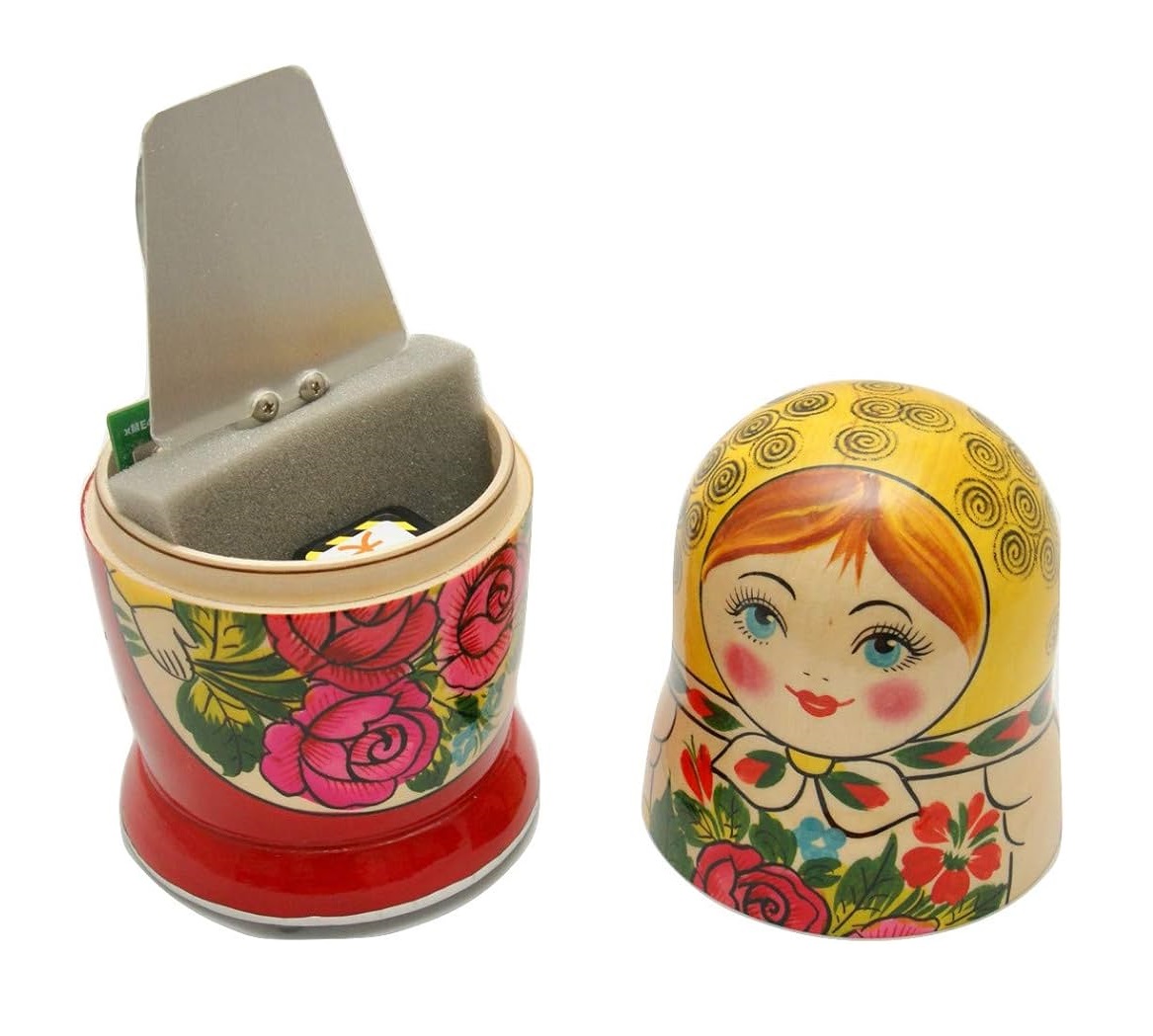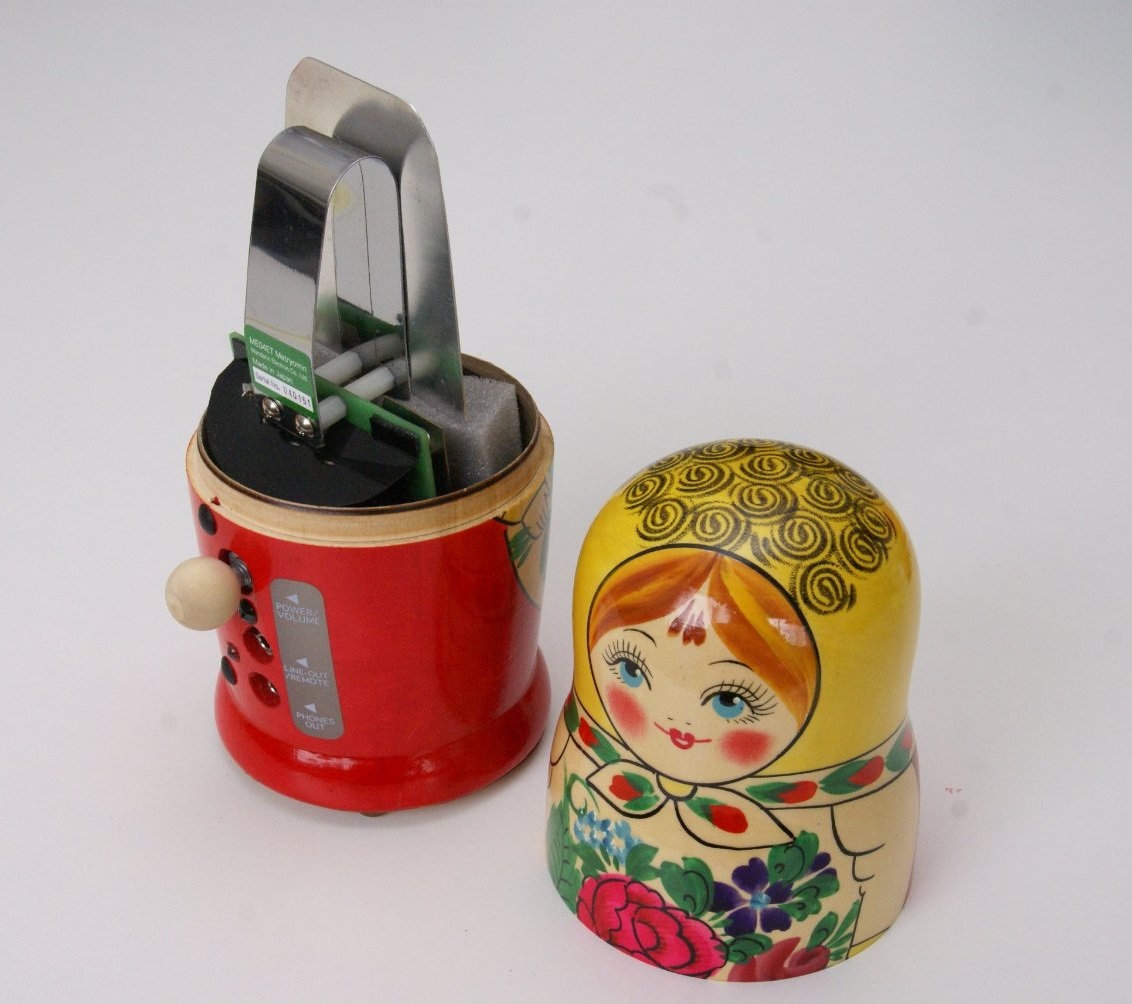Matryomin
Electronic Instruments
Asia
Between 1901 and present
Video
The Matryomin is a unique and captivating musical instrument that blends traditional cultural elements with modern technological innovation. Combining the influence of the theremin, a well-known electronic instrument, and the Matryoshka doll (the traditional Russian nesting doll), the Matryomin has become an intriguing example of cross-cultural fusion in the world of music. Designed with the structure of the Matryoshka doll in mind, it has a similarly nested form and is often seen as a symbolic representation of Russian folk culture, offering a visually appealing and whimsical experience in addition to its musical potential.
The instrument is primarily electronic, which allows it to create sound without physical contact. This makes it similar in some ways to the theremin, which is known for its capacity to produce eerie, otherworldly sounds that are played by manipulating electromagnetic fields around two antennas. The Matryomin, however, merges this concept with the aesthetic and design of the Matryoshka doll, resulting in an instrument that stands out as both a musical and a cultural artifact.
Type of Instrument
The Matryomin is classified as an electronic musical instrument that utilizes capacitive sensing technology to produce sound. It is a type of theremin, but it features a design that is inspired by the Matryoshka dolls. The capacitive sensors detect the proximity of the player’s hand, similar to the theremin, but the Matryomin’s design offers a distinct playing experience due to its specific interaction model. In terms of its sound production, the Matryomin falls into the category of analog synthesizers, but its sound can be shaped and altered through digital processing as well, making it versatile in terms of both tone and style.
This categorization as an electronic instrument means that the Matryomin relies on electrical circuits and oscillators to generate its sound. Unlike traditional acoustic instruments that produce sound through physical vibration, electronic instruments like the Matryomin use electric currents to manipulate sound waves and produce music in real time. The result is a broad palette of sonic possibilities that range from traditional sounds to more experimental, futuristic tones.
History of the Matryomin
Origin and Development
The Matryomin is a relatively modern invention that originates from Russia. As a hybrid instrument, it draws inspiration from two well-established sources in Russian culture: the theremin and the Matryoshka doll. The theremin was invented by Russian scientist Lev Termen (known in the West as Leon Theremin) in 1920. The theremin, one of the first electronic instruments ever created, has had a profound influence on the development of electronic music. Its invention marked the beginning of a new era in music-making, where electronic instruments played a significant role in shaping new soundscapes.
The Matryomin, however, is not simply a copy of the theremin. It was developed much later and draws upon the Russian tradition of the Matryoshka dolls, which are iconic symbols of Russian folk culture. The Matryoshka doll’s design—nesting dolls of decreasing sizes—is reflected in the Matryomin’s unique structure, creating a hybrid of technology and traditional cultural aesthetics.
The Matryomin gained attention when it was first showcased in Russia in the early 2000s, and since then, it has spread to other parts of the world. Its use of electronic components and interactive design has made it an intriguing novelty for musicians, technologists, and cultural enthusiasts alike.
The development of the Matryomin occurred in the 21st century, marking it as a modern innovation. While the theremin has a history dating back to the early 20th century, the Matryomin emerged in the 2000s as an intersection of Russian folk tradition and contemporary electronic technology. This timing is significant, as it occurred during a period of rapid technological advancement, where the possibilities of electronic sound production and design were becoming more sophisticated.
Construction
The Matryomin features a striking physical design that sets it apart from other electronic instruments. The primary body of the instrument is modeled after the shape of the Matryoshka doll. It consists of several nested, cylindrical wooden pieces that are stacked together, each of which can be painted in intricate, colorful designs that reflect the folk art associated with the Matryoshka doll.
At the heart of the instrument is the theremin-like electronic circuit, which includes sensors and oscillators. The capacitive sensors are embedded into the structure of the instrument, enabling the user to control the pitch, volume, and other aspects of the sound by moving their hands near the sensors. The sensor system is what differentiates the Matryomin from more traditional musical instruments. The instrument does not require any physical contact; instead, it responds to the proximity of the player’s hands, much like the theremin. The key components of the construction include:
- Outer casing: The shell of the Matryomin is made of wood, designed to resemble a Matryoshka doll. It is often painted in bright colors, reflecting traditional Russian folk art.
- Electronic components: These include capacitive sensors, circuit boards, and oscillators that generate and modulate the sound.
- Controls: The Matryomin often includes knobs or dials for adjusting sound parameters, allowing the player to manipulate the instrument’s tone and texture.
Types of Matryomin
The Matryomin comes in several variations, with differences primarily in size, sound quality, and the complexity of features. These variations can range from simple models designed for beginners to more advanced versions intended for professional musicians. Some of the main types include:
Basic Matryomin: This version is usually smaller and simpler in design, aimed at beginners or casual players. It often has fewer sensors and controls, focusing on the core experience of playing an electronic instrument without overwhelming the player with too many features.
Advanced Matryomin: More complex models come with additional features, including more refined sound-modulation controls, a wider range of pitch, and various preset sound settings. These are often used by professional musicians and can produce more sophisticated sounds.
Custom Matryomin: Some manufacturers allow musicians to customize the appearance and sound of their Matryomin. Custom options include changes to the woodwork, the addition of personalized electronics, and even the use of different materials to create a truly unique instrument.
Features of the Matryomin
The Matryomin’s features make it an intriguing and versatile instrument. Some key features include:
Capacitive sensors: These sensors detect the proximity of the player’s hands, allowing them to control pitch, tone, and volume.
Theremin-like controls: Like the theremin, the Matryomin uses electromagnetic fields to generate sound without physical contact.
Customizable sound options: With the ability to adjust the tone, volume, and effects, the Matryomin can create a wide variety of sounds, from eerie theremin-like tones to more conventional melodies.
Traditional Russian design: The Matryomin often retains the artistic elements of the Matryoshka doll, making it a beautiful object as well as a functional instrument.
Portability: Due to its relatively compact size, the Matryomin can be used in a variety of performance settings, making it adaptable for different types of musical expression.
Sound Production
The Matryomin produces sound in a way that is akin to the theremin. As the player moves their hands closer or farther from the sensors, they control the frequency and amplitude of the electronic signals, which are translated into sound. The primary way to produce sound is by varying the distance between the player’s hands and the instrument’s sensors. The closer the hands are to the sensors, the higher the pitch, while moving them further away lowers the pitch. By moving both hands independently, the player can create a wide range of expressive sounds, manipulating both pitch and volume simultaneously.
Because of its electronic nature, the Matryomin is capable of producing sounds that would be impossible for traditional acoustic instruments to achieve. The instrument can produce smooth, gliding pitches or sharp, staccato bursts, offering a level of expression that is unique to electronic music.
Playing Methods
Playing the Matryomin involves the use of both hands to control pitch and volume. The player must position their hands within the vicinity of the capacitive sensors, and as they move, they influence the tone. This method of playing is very much akin to the theremin, where the player’s movements create a seamless, fluid connection between their gestures and the resulting sound. The lack of physical contact with the instrument provides a certain freedom of movement, allowing the musician to “conduct” the music in a very expressive and fluid manner.
The instrument can be played standing or sitting, depending on the design of the Matryomin. Some players choose to accompany the Matryomin with other instruments, using its sound to add a unique texture to a larger ensemble. It is a highly intuitive instrument, with players often experimenting to create novel sounds through trial and error.
Roles in Music and Significance
The Matryomin occupies a special role in the world of music. While it is still considered an unconventional instrument, it has become a favorite among experimental musicians, electronic artists, and those interested in the intersection of technology and culture. Its ethereal, haunting sounds are often used in film scores, especially in scenes that require otherworldly or emotional tones.
In terms of cultural significance, the Matryomin acts as a bridge between Russia’s folk heritage and the futuristic possibilities of electronic music. Its design is a tribute to the Matryoshka doll, which is an iconic symbol of Russian art, while its electronic components represent Russia’s contribution to the development of modern music technology. As such, the Matryomin is both a celebration of tradition and an exploration of contemporary musical possibilities.
The instrument also represents a growing interest in non-traditional music-making methods. As digital and electronic instruments become more prevalent, the Matryomin exemplifies how new technologies can be harnessed to create rich, engaging sound experiences while maintaining cultural relevance. The Matryomin’s fusion of the old and the new makes it a significant instrument in the ongoing evolution of music and performance.
FAQ
What is the historical significance of the Matryomin?
The Matryomin combines elements of Russian and Japanese culture through its design as a matryoshka doll housing a theremin. It reflects innovations in electronic music since its inception in 2003 by Masami Takeuchi.
How does music created with a Matryomin differ from traditional instruments?
Music produced by a Matryomin relies on spatial manipulation rather than physical contact, allowing for ethereal sounds that are distinct from conventional instruments. This creates unique auditory experiences often associated with electronic music.
What role does the Matryomin play in contemporary music?
The Matryomin serves multiple roles including ensemble performances, educational purposes, and cultural representation, bridging gaps between different musical traditions while promoting creativity among musicians.
 Links
Links
References
 Similar
Similar
Instruments
Other Instrument
Categories



















